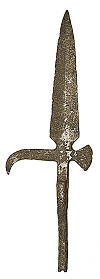 |

This page is dedicated to the presentation of a varied assortment of
Spanish colonial military artifact types.
Unlike the previous sections of this Internet museum—which are focused on the
interpretation of Spanish colonial military button and buckle forms—this area
serves to exhibit a potpourri of materials without regard to any predetermined typological
emphasis.
Above, Left:
Spanish halberd with bridle cutting beak, ca. 1740-1790, Escambia County, Florida |

|

|
SPANISH STAR SHOT
The star shot was a linked and
articulated type of naval artillery round designed to spread out after firing to shred,
tear, and mutilate an opponent's ship's rigging. Recovered in Pensacola, this example
is very similar to examples recovered from the wrecksite of the French frigate Machault,
which was scuttled to prevent its capture by the British during the battle of Restigouche
in Canada on 8 July 1760. |
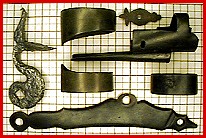
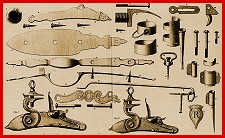
MODEL 1752 / 1757 SPANISH
MUSKET PARTS
The Model 1752 (also known as
the Model 1757) Spanish musket was a classic European flintlock longarm combining French,
German, and Spanish influences. This, along with a slightly modified version that
appeared in 1789, was the standard Spanish military musket from the 1750s until the end of
the Spanish colonial period. At above left are barrel bands, a sideplate, a wrist
escutcheon, and a hammer from Spanish sites in western Florida. At above right is
shown an official Spanish engraving of Model 1752/1757 musket furniture as well as carbine
and pistol locks and parts.

ORNATE PISTOL SIDE
PLATE
This elaborate, cast brass
pistol side plate's design consists of a central castle tower element flanked by a panoply
of flags. The castle tower was both an integral element in the Spanish royal coat of arms
and, later, the insignia for the Spanish Royal Corps of Engineers. The pistol that once
mounted this sideplate was not a standard military issue pattern. The weapon was almost
certainly custom ordered by and fabricated for an officer in the Spanish military
establishment or a government official. It was recovered in northwest Florida.
 |
SPANISH
OFFICER'S GORGET
This fragmented,
originally gilded brass Spanish officer's gorget was recovered in
Pensacola, Florida. Once approximately 5 5/8" / 14.4cm from tip to
tip, the engraved seal on the gorget's face, which lacks the Bourbon fleur
de lis in its center, is that of the Spanish Hapsburg
dynasty which came to an end in 1700.
|
 |
MODEL 1801 CARBINE LOCK
MECHANISM
The Model 1801 carbine was
probably among the last types of Spanish arms to be sent to the New World prior to the end
of the Spanish colonial period. This pattern is characterized by its brass (high copper
content) pan and the distinctive spur extension on the front of the hammer. |

|

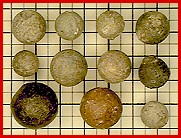
FLINTS AND SHOT
Shown above are Spanish musket,
carbine and pistol flints (left) and various sizes of lead shot for these weapons (right).
The flints are all prism-shaped, and the example in the upper left corner is actually of
French material. Such artifacts provide evidence of the often illicit but necessary trade
that took place between these neighboring colonial powers. Several of the lead shot,
which range in size from approximately 1.00 to .50 caliber, appear to have been cast in
stone molds.
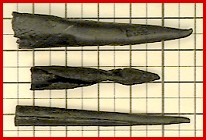
|
SPANISH ARROWHEADS
Far thicker and more crudely
fashioned than similar French trade arrowheads, the conical, hammer-coiled cast sheet
brass projectile points shown at top and bottom of the photograph at left were
intended for use by Spain's American Indian allies
within and beyond Florida. The projectile point shown at center is a copper
or brass crossbow quarrel or dart point made in the New World. Normally
associated with use by the earliest Spanish conquistadores
and explorers, evidence suggests that crossbows were used by Spanish
troops as late as the opening years of the 18th century in western
Florida. |
NAVAL
SWORD COUNTERGUARD
This badly damaged cast brass
naval sword counterguard exhibits classic Spanish workmanship. Upon the counterguard's
single shell is incised a design (which is highlighted here for illustration purposes)
consisting of an upright anchor whose shaft forms the back element of a stylized Roman
letter "R," the remainder of which extends outward from the central naval motif.
It is postulated that this device may artistically represent the words Real Marina, which
literally means "Royal Navy" and which was also the official designation for
members of the Spanish Royal Marine Infantry and Artillery. |
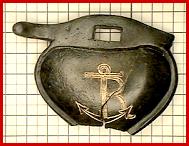
|
 |
FLAMING
BOMB DEVICE
The flaming bomb device was
variously applied by European and American military establishments as insignia
for infantry grenadiers as well as officers and men of
artillery and ordnance branches. This die-stamped and hand-trimmed brass example,
which may have been made in Britain for use by the Spanish military establishment during
the 1808-1814 period, has been rudely double-punch-perforated at its top, bottom, and side
edges for attachment with heavy thread or small staples. The exact mode of use and
placement for this remains uncertain. It may have adorned the fur cap of a Spanish
grenadier or a grenadier's or artillerist's cartridge pouch. |
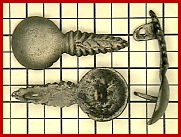 |
ARTILLERISTS'
COLLAR DEVICES
These small flaming bomb
insignias adorned the collars of Spanish artillerymen. The cast brass
example at left is of Spanish manufacture, ca. 1802-1808; it is slightly
curved to accommodate the contour of the collar and was secured to that
uniform component via two drilled shanks like those found on cast Spanish
buttons. The example at right is of die-stamped sheet brass whose original
soldered attachment wires are absent. This is very probably of
post-1808 British manufacture; similar devices adorned the collars of
Spain's artillery uniforms well into the twentieth century. |
 |
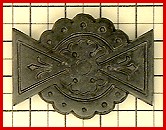
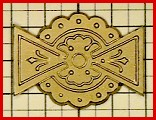
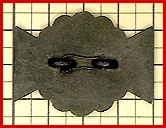
• UNIDENTIFIED •
Found in the remains of the
Spanish siege lines of the March-May 1781 battle of Pensacola was this carefully crafted
cast brass ornament or badge which was attached to its leather or cloth host by two
drilled shanks (like those on cast brass Spanish military buttons of the period) which are
located on the artifact's flat reverse face (right). The two shanks are still
connected by a thin piece of twisted silver wire, suggesting that this was still attached
to its host when it was lost. The original's face is shown at left, while a casting is
shown at center to enhance the details' visual clarity. It has been postulated that this
may have served as a cartridge pouch device, a coat tail tie back emblem, or even a form of
cockade or shoulder strap insignia. Any viewer who may be able to provide information
about this artifact is encouraged to contact the curator via the e-mail link at this
site's home page.
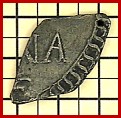 |
PEWTER CAP
PLATE FRAGMENT
This cut
fragment of a ca. 1808-1820 pewter cap or shako plate was recovered in
western Florida at a late Spanish colonial military site. Such destruction
of military equipment was not uncommon; often, trimmed pieces of shako
plates were put to use as flint caps to hold gunflints securely between
the jaws of musket cocks. This fragment only yields tantalizing
hints regarding the identity of its original regiment or battalion of
issue; the "-NA" could stand for either "Tarragona" or
"Luisiana", both of which Spanish units served in Florida during
the period. One of the original attachment perforations remains in the
upper right corner of this specimen. |
CAMP
AND PERSONAL GOODS
Artifacts like those at right
are found at the home and camp sites of nearly all military personnel during the colonial
and early American national periods. The items shown are as follows: (A) coat tail
weights made from flattened lead shot; (B) lead pencils; (C) porcelain dice (bone dice
were also commonly used); (D) long coat or jacket hook fastener; (E) gaming chip made from
flattened musket ball; and (F) brass juice harp. |

|
Acknowledgments:
Chris Bennett; Neal Collier; Robert Commings; Dr. J.
"Coz" Cozzi; Eugene Gruenewald; Dr. H. Louis Hill, Jr.; James E. Pierce; Pensacola Historical Society; Allen L. Roach;
John and Rosemary Sanders; Arthur, Imogene, and Samuel Standard; Bennett and Martha Tillison

Return to Home Page






















